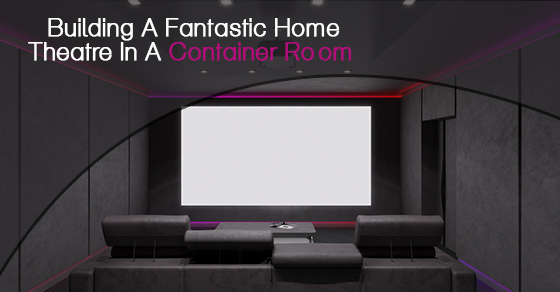
Some people believe that good entertainment space should be large enough to accommodate a huge TV and speakers, but size is not that big a factor. Actually, you can convert any space into a suitable home-theatre space by finding the right electronics and applying the appropriate space between your seat and the screen for the best video viewing.
Here is how to convert your container into a great home theatre space:
Step 1: Prepare the space
A rectangular space is ideal for a media room because symmetrical areas are easier to soundproof. So, you can start by covering all the hard surfaces because they reflect sound, including the floor. This will prevent muddy dialogue and the amplification of sound effects. You can get the container carpeted and the furniture upholstered to absorb sound waves.
Depending on your budget, you can install acoustic tiling to soundproof the walls, or simply hang thick drapes or paintings or set up a bookshelf to keep unwanted sound from bouncing around the space. The curtains and dimmer switches will help to increase contrast and reduce glare.
Step 2: Map out your space
It is important that you figure out where everything will go while the space is still empty. Measure distances, like between your sitting position and where the screen will be placed, so you can use the measurements to identify the ideal screen size. Consider mounting your TV on the wall, and adjust the light setting so the space is appropriately dark.
Step 3: Choose the equipment
Screen – When choosing a big screen TV, keep in mind that the distance between the screen and your sitting position should be about three times the screen’s size, with 27 inches being the minimum screen size. You may also want to consider using a projector in place of a TV, which you simply mount from the ceiling and then use any wall as a screen. In this case, you will still need to consider the viewing distance and other factors.
Speakers – A standard home-theatre setup comprises one subwoofer and five speakers. You will need a receiver to decode the input and direct it to the outputs – speakers and TV. The receiver should come with a power amp and preamp, though you can also purchase these separately. Alternatively, you can use sound bars, which are typically slim, amplified, and self-powered so there is no need for a receiver.
Media player – This depends on the format in which most of the media is stored, but you’ll probably need a progressive-scan DVD player or a Blu-Ray player. Ensure that you have the right cords and adaptors to connect the equipment.
Finally, keep in mind the best practices when organizing the cables and wires and stacking your equipment. Avoid placing electronics too close to the wall to prevent overheating; don’t bundle or coil your wires; and consider purchasing one or two extra vents (supplied by SCS) for more air circulation and to prevent condensation inside the container.

Leave a Reply